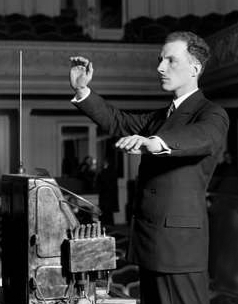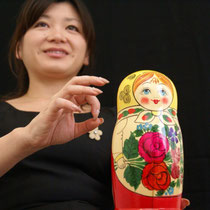
The original matryoshka set by Zvyozdochkin and Malyutin, 1892
They sit in rows, earphones on, doll in hand, and hand poised. A sound emerges, as much like singing as you can imagine.
It’s a matryomin ensemble.
Invented in 2003 by Japanese theremin player Masami Takeuchi, the matryomin combines two Russian cultural objects: a small theremin and a matryoshka doll. Matryoshka dolls are nesting wooden dolls – as you open one, another is revealed inside. The original dolls, created in the late 19th century by wood carver Vasily Zvyozdochkin and folk craft painter Sergey Malyutin, were a mother and her children, with the innermost doll being a baby.
Modern sets are often on themes such as political leaders or animals. There’s a music set with Mozart – Beethoven – Bach – Haydn – with Brahms as the baby. I’m not sure we’d all agree on that order!

Léon Theremin playing, 1927
The theremin dates from the 1920s. Invented by Russian inventor Léon Theremin, the instrument usually looks like a box with antennas coming out of one side and the top.
Unique among musical instruments in that it is played without actually touching the instrument, the theremin’s two antennas control pitch and volume. Higher notes are played with the hand close to the pitch antenna and louder notes by pulling your hand away from the volume antenna. One of the great theremin performers was Clara Rockmore. She worked with Theremin to develop the instrument and then did tours of America with the instrument starting in the 1930s. As you see her play, her hands seem to be tracing an unseen melody in the air.

Alexandra Stepanoff playing the theremin on NBC Radio, 1930
Rockmore noted that the sensitivity of the instrument meant that each gesture had to be intended. She said once, that, as a player, “You cannot register any of your internal emotion at all. You cannot shake your head, for instance, or sway back and forth on your feet. That would change your tone.”
The theremin captured the early 20th century fascination for science by being part of the compositional repertoire of composers such as Dmitri Shostakovich (for the film Odna) and Miklós Rózsa (for the films Spellbound, The Red House, and The Lost Weekend). A simplified version of the theremin, the Electro-Theremin, was created for the Beach Boys for use in songs such as Good Vibrations. Contrary to popular belief, it was not used for the outer-space sounds of Star Trek.
Masami Takeuchi was probably Japan’s only theremin player. He studied the theremin in Russia and brought the instrument back to Japan.

Matryomin being played
As he sought to popularize the instrument in his home country, he developed the matryomin to make the instrument more accessible. The matryomin is a ‘one-antenna theremin,’ omitting the volume antenna and putting the instrument in an easily carried, and played case. Japan went from having a single theremin player to having thousands.
The popularity of the instrument led to Takeuchi’s ensemble of 272 players achieving the Guinness World Record for “Largest Theremin Ensemble”. This ensemble of 167 players takes on Beethoven’s Symphony No. 9, but with a boogie beat.
One of the keys to the matryomin ensemble’s sound is that each instrument is tuned to a slightly different pitch – instead of a single unified sound, we get that wonderful depth of range that we expect to hear from an ensemble. Whoever said that playing with dolls was a waste of time! You can use your doll for music!




Please provide further info on Theremin. How it came around…Thks!